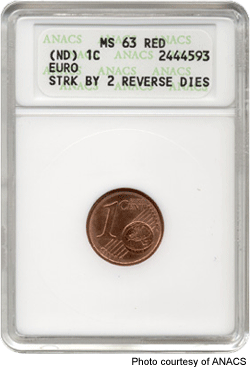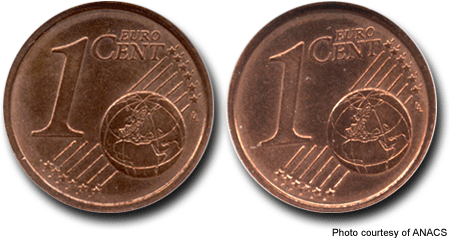 On January 1, 2001 the Euro officially became the first common European Currency, replacing the individual National Currencies of the 12 Member Countries of the European Monetary Union. These countries are: Austria, Belgium, Finland, France, Germany, Greece, Ireland, Italy, Luxemborg, Netherlands, Portugal and Spain.
On January 1, 2001 the Euro officially became the first common European Currency, replacing the individual National Currencies of the 12 Member Countries of the European Monetary Union. These countries are: Austria, Belgium, Finland, France, Germany, Greece, Ireland, Italy, Luxemborg, Netherlands, Portugal and Spain.


 Every Euro Coin carries a common reverse design. Each of the 12 Member Countries strike the Euro with its own unique obverse design. Regardless of which Country is depicted on the obverse of a Euro Coin, it is accepted in any of the 12 Member Countries.
Every Euro Coin carries a common reverse design. Each of the 12 Member Countries strike the Euro with its own unique obverse design. Regardless of which Country is depicted on the obverse of a Euro Coin, it is accepted in any of the 12 Member Countries.
 Euro Coins were minted starting in 1999. Not every country struck every denomination of Euro Coins in the first year. By the beginning of 2001 each country had a sufficient supply of Euro Coins on hand. Euro coins were then distributed and released into circulation.
Euro Coins were minted starting in 1999. Not every country struck every denomination of Euro Coins in the first year. By the beginning of 2001 each country had a sufficient supply of Euro Coins on hand. Euro coins were then distributed and released into circulation.
 This Euro Cent was struck with 2 reverse dies. Considering that billions of Euro coins have been struck in the last four years from 12 different countries, it is amazing that only a few small groups have been discovered so far.
This Euro Cent was struck with 2 reverse dies. Considering that billions of Euro coins have been struck in the last four years from 12 different countries, it is amazing that only a few small groups have been discovered so far.
 The two tailed Euro Cent featured here is the discovery coin that was submited to ANACS by Mike Byers of Byers Numismatic Corp. ANACS was featured in an article on this coin in the October 7, 2002 Issue of Coin World.
The two tailed Euro Cent featured here is the discovery coin that was submited to ANACS by Mike Byers of Byers Numismatic Corp. ANACS was featured in an article on this coin in the October 7, 2002 Issue of Coin World.


